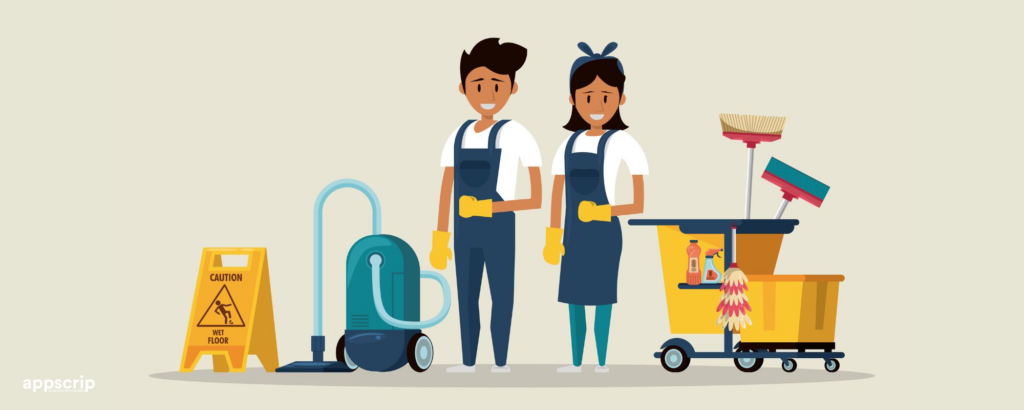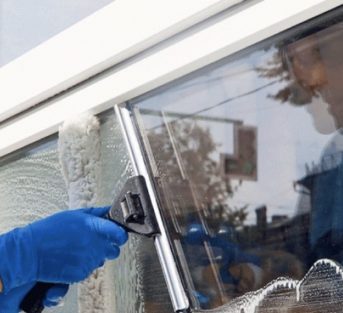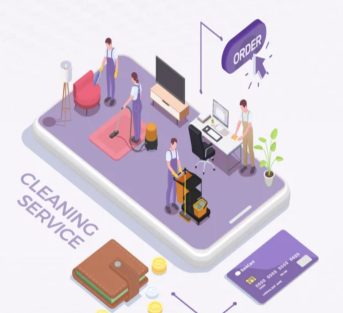There is a lot of opportunity in the house cleaning business, as the industry is expected to reach $138 billion in size by 2034. Professional cleaning services are in high demand due to more busy lifestyles, increased hygiene awareness, and an increasing number of dual-income families. Having a clear plan will help your business appeal to these fast-paced lifestyle clients and enable your cleaning business to be more popular.
An essential part of that plan is a detailed checklist. Having a checklist helps you stay organized and consistent by making sure you never overlook anything. It can help you with important tasks like getting licenses, marketing, and organizing your team, all while making sure you give your clients reliable, high-quality services.
Modern apps and tools can be very helpful in running your business efficiently. You can save time and reduce errors by adopting cleaning business software for tasks like job scheduling, payment tracking, and customer communication. Additionally, these tools let you concentrate more on expanding your business and less on handling routine jobs.
Whether you’re beginning small or looking to expand, this checklist will walk you through everything you need to know to start and develop a successful house cleaning service.
Benefits of a Comprehensive Checklist for Organization and Client Satisfaction
A thorough checklist ensures that service is always consistent, high-quality, and up to client standards.
Better Organization
A checklist breaks larger tasks into manageable actions, making it easier for employees to stay focused and productive.
For example, you can put together a room-by-room checklist: dust furniture, vacuum carpets, sanitize commonly touched surfaces, and mop floors. Changing checklists to fit the requirements of each client can help you stand out and provide personalized services.
Consistency in Service Quality
Using a checklist makes sure your team follows the same procedure for every cleaning job, which maintains service quality and builds trust. Your checklist will continue to meet client standards and get better over time if you frequently review it with your team and make changes based on feedback from clients.
Professional Image
A thorough and complete checklist shows that you are dedicated to being professional. Clients see that the whole space is cleaned to a high standard. Offering your clients a copy of your checklist helps them understand the services they are getting, which builds trust over time.
Effective Training for Employees
A clear, step-by-step checklist makes it easy for new employees to get up to speed quickly. This cuts down on the learning curve and ensures consistent performance from day one. Including the checklist and hands-on training in the onboarding process will help new workers fully understand your cleaning standards and keep up the quality.
Better Time Management
A checklist helps employees organize their tasks and stay on task, which means they can finish jobs faster without lowering the standard. Including estimated time frames for each task allows staff to manage their workload more effectively, ensuring tasks are done on time.
Steps to Start a House Cleaning Business
You need to do more than just offer cleaning services when you start a house cleaning business. You must build a strong foundation by planning, setting goals, and understanding the market. Here are the key steps:
Determine the Types of Cleaning Services to Offer
Residential Cleaning: This is done in smaller areas like homes or apartments. It includes vacuuming, dusting, mopping, sanitizing kitchens and bathrooms, and more. To keep long-term customers, it’s essential to understand each homeowner’s unique needs. This will help you build strong client relationships. Find out if the local demand for residential services fits your resources and goals by looking at the demand in that region.
Commercial Cleaning: Commercial cleaning is for more prominent places like warehouses, offices, or shops. It includes wiping down floors, disinfecting common areas, emptying trash cans, and keeping track of bathroom supplies. Commercial jobs frequently require flexibility to accommodate after-hours or particular schedules. Invest in equipment that can handle big spaces, and maybe even recruit more people to provide this service.
Specialized Services: There are also specialized services, such as move-in/move-out cleaning for owners and tenants, deep cleaning for one-time jobs, and eco-friendly cleaning with sustainable, non-toxic products. These customized services are tailored to specific client groups and could fetch higher rates. To determine which niche services will give you an edge, look into what your competitors are offering and what clients in your area want.
Create a Detailed Business Plan
Executive Summary
Your executive summary is the first thing investors or partners will read. Keep it clear and to the point. It should give a snapshot of your business, showing why it has the potential to succeed.
- Business Overview: Clearly describe what your cleaning business offers, whether it’s residential, commercial, or specialized services.
- Target Market: Identify your ideal customers. Are you serving busy homeowners, businesses that need overnight cleaning, or realtors needing move-out services?
- Competitive Edge: Explain what makes your business stand out. Do you offer flexible schedules, better rates, eco-friendly products, or high-end deep cleaning services?
- Goals and Vision: Define your short-term and long-term plans. Are you starting as a solo cleaner and hiring staff later? Do you plan to expand into commercial cleaning in the future?

Market Analysis
Market analysis is essential for smart decisions and standing out from competitors.
- Competitor Research: Identify who else offers cleaning services in your area. What do they charge? What services do they provide? Are there gaps in their service that you can fill?
- Customer Demand: Learn what potential clients need. Are homeowners looking for weekly cleanings? Do businesses require after-hours janitorial services? Does your area have a demand for eco-friendly cleaning?
- Pricing Strategy: Compare local rates. Setting prices too low might not cover expenses, while high rates could drive away customers. Find a balance that keeps you competitive and profitable.
- Marketing Insights: How do potential clients find cleaning services? Do they rely on word-of-mouth, online reviews, or social media? Understanding this helps shape your marketing approach.
- Opportunities for Growth: Identify ways to expand. Could you introduce new services? Would bundling cleaning packages attract more customers? Thinking ahead will help you scale your business effectively.
Financial Projections
Carefully planning your finances prevents losses and ensures profitability.
- Startup Costs: List everything you need to get started, including cleaning supplies, insurance, business licenses, and marketing.
- Operating Expenses: Factor in ongoing costs like employee wages, fuel for transportation, restocking supplies, and maintaining equipment.
- Pricing Strategy: Determine your rates based on labor, supply costs, and market trends. Offer competitive pricing while ensuring you make a profit.
- Break-even Point: Calculate how many cleaning jobs you need to cover expenses before making a profit. Understanding this helps with realistic goal setting.
- Revenue Projections: Estimate how much you expect to earn in the first six months to a year. If growth is part of your plan, forecast when you might hire staff or expand services.
- Contingency Planning: Plan for unexpected expenses. Setting aside funds for emergencies, such as equipment repairs or slow business periods, will help keep your business stable.
How to License and Complete Legal Requirements
Starting a house cleaning company requires specific legal procedures to remain compliant and guard yourself from risks. Here is what you should do:
Register Your Cleaning Business
- Choose a Business Structure: Choose between operating as a single proprietorship, limited liability company (LLC), or corporation. A lot of people choose an LLC because it has personal liability protection and makes taxes easy.
- Register Your Business Name: Choose a unique name and use your state’s business registration page to see availability. File a “Doing Business As” (DBA) if you want to do business under a name other than the one your business is listed under.
- Apply for an EIN: If you plan to hire employees, you need an Employer Identification Number (EIN) from the IRS. This is also useful for tax and banking purposes.
- State and Local Registration: Depending on where you live, you might have to register with state agencies, get a sales tax permit, or apply for a home-based business license.
Secure Necessary Permits and Insurance
- Business License: You will need a business license to get started. See what is needed by contacting your local government. Ensure that you comply by consulting your local government.
- Bonding: Many clients prefer bonded cleaning services for security. A surety bond guarantees compensation in case of theft or contract violation.
- Liability Insurance: Liability insurance guards against claims of personal injury or property damage brought about by cleaning services. Getting insurance that covers both general liability and worker’s compensation is important if you want to hire people.
- Workers’ Compensation Insurance: Usually mandated for businesses with employees in most states. It covers medical expenses and lost wages if an employee gets injured.
- Vehicle Insurance: Commercial auto insurance is crucial to cover mishaps and damages should you or your employees drive business vehicles for cleaning duties.
Equipment and Supplies Checklist
Proper equipment helps to improve cleaning quality, save time, and ensure customer satisfaction. Below is a list of the essential cleaning supplies and specialized equipment you’ll need.
Essential Cleaning Supplies
- Multipurpose Cleaners: Effective for most surfaces, reducing the need for multiple products.
- Disinfectants: Necessary for sanitizing high-touch areas like doorknobs, countertops, and bathroom fixtures.
- Glass Cleaner: Keeps mirrors and windows streak-free.
- Microfiber Cloths: Great for dusting and general cleaning without leaving lint or streaks.
- Mops and Buckets: Required for floor cleaning in homes and offices.
- Vacuum Cleaner: A reliable vacuum with different attachments helps clean carpets, upholstery, and hard-to-reach spots.
- Scrub Brushes and Sponges: Useful for scrubbing sinks, bathtubs, and kitchen surfaces.
- Trash Bags: Always keep a supply for easy disposal of waste.
- Protective Gloves: Essential for handling cleaning chemicals safely.
Specialized Equipment for Deep Cleaning
- Steam Cleaner: Helps remove tough grime and sanitizes surfaces without harsh chemicals.
- Carpet Cleaner: Ideal for deep-cleaning carpets and removing stains.
- Pressure Washer: Useful for outdoor cleaning, including driveways and patios.
- HEPA Filter Vacuum: Captures fine dust and allergens, great for homes with pets or allergy-sensitive clients.
- Grout Brush and Tile Cleaner: Helps clean and restore tiled surfaces in bathrooms and kitchens.
Additional Tools
- Extension Duster: Reaches high areas like ceiling fans and vents.
- Lint Rollers: Useful for picking up pet hair and lint from upholstery.
- Labelled Spray Bottles: Keep cleaning solutions organized and easily accessible.
- Caddy or Tool Belt: Helps efficiently carry essential supplies during cleaning jobs.
Service-Specific Checklists
A straightforward checklist for each type of cleaning service ensures consistency and high-quality results. Whether handling routine or specialized deep cleaning jobs, these checklists help streamline tasks and maintain customer satisfaction.
Regular Cleaning Checklist
A standard cleaning routine keeps homes and offices fresh and well-maintained. Focus on high-traffic areas and frequently used surfaces.
- Dust furniture, shelves, and baseboards.
- Vacuum carpets, rugs, and upholstered furniture.
- Mop and disinfect hard floors.
- Sanitize high-touch areas like doorknobs, light switches, and countertops.
- Empty trash bins and replace liners.
- Clean mirrors and glass surfaces.
- Wipe down kitchen appliances and countertops.
- Scrub sinks and disinfect bathroom fixtures.
Deep Cleaning Checklist
Deep cleaning tackles built-up dirt and grime, making spaces feel like new. This service is ideal for periodic maintenance or preparation for special events.
- Clean inside appliances like ovens, refrigerators, and microwaves.
- Scrub grout in tiled areas.
- Wash baseboards, doors, and window sills.
- Dust and clean ceiling fans and vents.
- Shampoo carpets or use a steam cleaner.
- Wash curtains or wipe down blinds.
- Polish furniture and remove water stains.
- Disinfect and deodorize garbage cans.
Move-Out Cleaning Checklist
Move-out cleaning ensures rental properties or homes are spotless for new tenants or owners. Landlords and real estate agents often request this service.
- Remove cobwebs from ceilings and corners.
- Wipe down all walls and spot clean stains.
- Deep clean kitchen cabinets, drawers, and shelves.
- Scrub and sanitize all bathroom surfaces.
- Vacuum and mop floors, ensuring no dust or debris remains.
- Clean light fixtures, switches, and outlets.
- Ensure all appliances are spotless inside and out.
- Check every room for any remaining trash or forgotten items.
Room-by-Room Checklist
For highly detailed cleaning, breaking down tasks by room helps maintain thoroughness and efficiency.
- Kitchen: Wipe cabinets, sanitize sinks, clean stove tops and appliances.
- Bathroom: Disinfect toilets, shine fixtures, scrub tubs and showers.
- Living Room: Dust furniture, vacuum upholstery, clean windows and mirrors.
- Bedrooms: Change bed linens, dust surfaces, vacuum carpets or mop floors.
- Entryways & Hallways: Sweep floors, wipe down doors, clean light switches.
Using these structured checklists ensures that every cleaning job meets high standards.
How to Hire and Train Employees
A skilled team delivers reliable service and completes jobs faster without cutting corners. Here’s how to find and train the right employees.
When to Hire Additional Staff
- Increased Demand: If you’re turning down jobs or struggling to keep up with bookings, hiring more employees to meet customer needs is time.
- Expanding Services: If you plan to offer specialized services like deep cleaning or eco-friendly cleaning, hire workers with experience in those areas.
- Maintaining Quality: If your workload affects service quality, bringing in extra staff helps maintain high standards and keeps clients happy.
- Growing Your Business: More employees allow you to take on more significant contracts, expand to new locations, and increase revenue.
Finding the Right Employees
- Referrals and Networking: Ask current employees, clients, and business contacts if they know reliable candidates.
- Job Listings: Post job openings on websites, social media, and community job boards to attract many applicants.
- Interview Process: Screen candidates based on experience, reliability, and work ethic. Ask scenario-based questions to see how they handle challenges.
- Background Checks: Verify references and run background checks to ensure employees are trustworthy and professional.
Effective Training Programs for Quality Service
- Step-by-Step Cleaning Methods: Teach employees a structured cleaning process to ensure consistency and thorough results.
- Proper Use of Supplies and Equipment: Show employees how to handle cleaning solutions, vacuums, and specialized tools safely and efficiently.
- Time Management Skills: Train employees to clean effectively within a set timeframe to complete jobs on schedule without rushing.
- Customer Interaction and Professionalism: Teach employees how to communicate politely with clients, handle concerns, and respect client privacy.
- Workplace Safety and Compliance: Provide safety training on handling chemicals, preventing injuries, and following local cleaning regulations.
- Ongoing Training: Hold regular refresher sessions to introduce new cleaning techniques, products, and company policies.
Strategies to Market and Advertise Your Cleaning Business
A good marketing plan can make your business recognizable, bring in leads, and retain customers. Managing customer contacts, automating scheduling, and making operations easier can be done with the right tools and strategies, such as cleaning service software.
Branding Essentials
Create a Professional Logo and Tagline: Create a lasting impression and establish your business identity with a recognizable logo and memorable tagline.
Build a User-Friendly Website: Include your services, prices, and contact information. Ensure that a booking option is available to enable clients to schedule appointments conveniently. A cleaning management software can help you keep track of customers and schedules all from one place on your site.
Use High-Quality Images: Showcase the excellence of your job by displaying before-and-after cleaning results. Seeing visual proof of efficiency helps clients to trust a service more than anything else.
Use cleaning management tools: Schedule appointments automatically, bill, and interact with customers using Appscrip’s cleaning services software. This guarantees you never miss a booking and allows you to offer professional, timely service free from needless no-shows.
Digital Marketing
Social Media Presence: Post cleaning tips, special offers, and client success stories on platforms like Facebook and Instagram. Engage with potential customers through comments and direct messages.
Search Engine Optimization (SEO): Optimize your website with relevant keywords so potential customers can find you easily online. A cleaning management system can help track website traffic and refine your SEO strategy.
Paid Ads: Use Facebook Ads or Google Ads to target specific demographics. With the right software, you can track ad performance and adjust campaigns to get the best value from your budget.
Simplify your marketing tasks: Use cleaning service software to handle email campaigns, issue reminders, and run promotions which simplifies your marketing activities. By reminding prior clients of your offerings, automated follow-ups help to increase recurring business.
Offline Marketing Strategies
Flyers and Business Cards: Distribute them in high-traffic areas like neighborhoods, apartment complexes, and community centers.
Partner with Local Businesses: Work with local businesses, including real estate brokers, property managers, and home service providers, to get referrals. Track these recommendations using a digital client management system, then reward partners appropriately.
Vehicle Branding: Add your logo and contact details to your company vehicle to increase brand exposure while on the go.
Word-of-mouth Marketing: Offer referral bonuses and discounts to clients who suggest your services as part of word-of-mouth marketing. Track and automate referral incentives using a CRM system.
Streamline Client Referrals: A referral program software solution can automatically manage referrals, track customer history, and apply discounts, making it easier to reward loyal clients.
Building Client Trust Through Reviews and Testimonials
Request Client Reviews: Encourage satisfied customers to leave reviews on Google, Yelp, and Facebook. Automated review request emails can help boost response rates.
Showcase Testimonials: Feature positive feedback prominently on your website and in marketing materials. A customer management system can collect and organize testimonials for easy access.
Consistently Deliver Great Service: Providing top-quality cleaning and excellent customer service leads to repeat business and word-of-mouth recommendations. Scheduling software ensures you can manage appointments efficiently and avoid overbooking.
Use a CRM for Customer Management: Keep track of client preferences, past services, and upcoming appointments. A cleaning service management platform helps personalize customer interactions, boosting satisfaction and retention.
Conclusion
From selecting the correct services and licensing your business to marketing and recruiting employees, every step is essential for the success of a house cleaning business. A well-defined checklist guarantees client service quality and helps maintain seamless operations.
Appscrip’s cleaning service management software simplifies and speeds up routine tasks, including client management, billing, and scheduling. Automating these tasks helps you to concentrate on providing first-rate cleaning services, saves time, and minimizes errors. Using real-time appointment monitoring, automated billing, and seamless client communication, Appscrip’s software enables businesses to operate efficiently and grow without hassle.
Following these strategies helps you attract loyal customers, expand steadily, and stand out from competitors. Keep refining your processes, staying updated on industry trends, and always providing reliable, high-quality cleaning services. Investing in the right tools ensures that your business operates smoothly and stays ahead of the competition.
Get started today and see how automation can simplify the daily operations of your house-cleaning business!
Frequently Asked Questions (FAQs)
How can I start a cleaning business with minimal investment?
Start small by offering essential cleaning services and using affordable supplies. Focus on word-of-mouth referrals and free marketing strategies, like social media, before spending on ads. As you grow, reinvest profits into better equipment and marketing. Appscrip’s cleaning service software can help manage bookings and customer records from day one, making operations more efficient even with a small team.
How do I price my cleaning services competitively?
Research local competitors and set rates based on service type, home size, and cleaning frequency. Charge enough to cover expenses while keeping prices attractive. Offering package deals or discounts for recurring clients can help maintain a steady income.
What software can help manage a cleaning business?
Appscrip’s cleaning service software helps with scheduling, invoicing, customer tracking, and automated reminders. It improves efficiency and allows businesses to scale operations smoothly. Mobile access and real-time updates keep your team and clients connected, easing workflows and reducing manual work order management.






